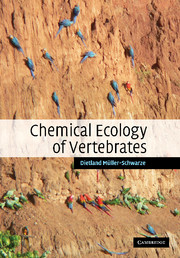Book contents
- Frontmatter
- Contents
- Preface
- Acknowledgements
- 1 The odorsphere: the environment for transmission of chemical signals
- 2 Properties of vertebrate semiochemicals
- 3 Odor production and release
- 4 Chemical cues in orientation and navigation
- 5 Chemoreception
- 6 Signaling pheromones I: discrimination and recognition
- 7 Signaling pheromones II: sex and alarm pheromones and evolutionary considerations
- 8 Intraspecific signals: priming pheromones
- 9 Development of intra- and interspecific chemical communication
- 10 Allomones I: chemical defense by animals
- 11 Allomones II: plant chemical defenses against herbivores
- 12 Kairomones and synomones
- 13 Practical applications of semiochemicals
- Glosssary
- References
- Index
11 - Allomones II: plant chemical defenses against herbivores
Published online by Cambridge University Press: 23 November 2009
- Frontmatter
- Contents
- Preface
- Acknowledgements
- 1 The odorsphere: the environment for transmission of chemical signals
- 2 Properties of vertebrate semiochemicals
- 3 Odor production and release
- 4 Chemical cues in orientation and navigation
- 5 Chemoreception
- 6 Signaling pheromones I: discrimination and recognition
- 7 Signaling pheromones II: sex and alarm pheromones and evolutionary considerations
- 8 Intraspecific signals: priming pheromones
- 9 Development of intra- and interspecific chemical communication
- 10 Allomones I: chemical defense by animals
- 11 Allomones II: plant chemical defenses against herbivores
- 12 Kairomones and synomones
- 13 Practical applications of semiochemicals
- Glosssary
- References
- Index
Summary
The plant world is not colored green; it is colored morphine, caffeine, tannin, phenol, terpene, canavanine, latex, phytohaem–agglutinin, oxalic acid, saponin, l-dopa, etc.
janzen (1978)Herbivores select certain plant species or parts and reject others. Plant defenses determine food choices as much as nutritional value does. Plants can defend themselves mechanically as with thorns, hairs, waxes, or structural fibers, and chemically with secondary plant compounds. Mammals have had to cope with plant defenses since they adapted to an herbivorous lifestyle approximately 85–100 millions years ago (Archibald, 1996).
In 1888, Stahl suggested that plants use toxic chemicals as defense against herbivores based on his feeding experiment with snails. Fraenkel (1959) postulated that “secondary compounds in plants exist solely for the purpose of repelling and attracting insects.” We now know that these compounds are aimed at vertebrates, other invertebrates, and microbes as well, and in many cases their roles are still being debated. Here I apply the term “allomone” in its widest sense: compounds that benefit the “sender,” even though many are not “signals” in the strict sense. Therefore, “donor” or “originator” organism is a better term. In the metabolism of the herbivore, the receiving organism, such foreign compounds are termed xenobiotics, whether natural or synthetic.
The interactions of plants and vertebrate herbivores can be broken down into several questions.
What defense compounds do plants use?
What are their effects on mammalian and avian herbivores?
What defense strategies do plants use? This includes species differences based on ecological needs; variations of plant defenses between plant parts (leaf, bud, internode, terminal shoot, bark, root) or growth stages that correlate with vulnerability; and seasonal variation of plant defenses.
[…]
- Type
- Chapter
- Information
- Chemical Ecology of Vertebrates , pp. 270 - 337Publisher: Cambridge University PressPrint publication year: 2006



